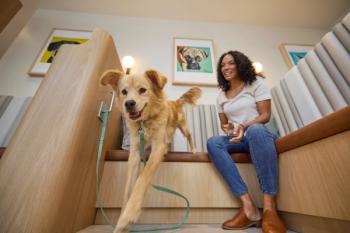
Hanging with Hafen: A case for getting rid of waiting rooms
One of the biggest parts of your job is keeping clients happy. But how can you do that when they're stuck in your lobby for hours on end?
A couple of months ago, I think I set a record for the longest time spent in an emergency room: eight hours and thirty-two minutes. What’s worse, in the end they didn’t do a thing but send me home. Talk about frustrating.
Every time I have any interaction with the human healthcare machine, I come away feeling like I’ve been mauled by a large and well-meaning but inept beast. And I wonder how veterinary medicine could be improved.
I recently read an article about an emergency room built for Penn State University’s Hershey Medical Center. The article described how human medicine is wrestling with streamlining the way emergency room patients are received, processed, treated, and released. And it included a term for the phenomenon of patients who get fed up and walk out of emergency: the reneging factor.
The reneging factor is a big problem for human healthcare for three reasons:
1. The patient doesn’t get treated.
2. The patient is unhappy.
3. The hospital loses money.
The Hershey Medical Center’s solution was to eliminate the emergency waiting room. In Lean Six Sigma for Healthcare (ASQ Quality Press, 2005), Greg Butler, Chip Caldwell, and Nancy Poston say, “Healthcare is the only industry … that actually has a name for a major category of waste … waiting rooms. Most organizations outside of healthcare would go bankrupt if they thought like this.”
IT’S TIME FOR A NEW MODEL
You have to admit that the whole concept of a waiting room is a misalignment of resources. Queuing theory, or the study of why people stand in lines, is a science that goes to great effort to reconcile three things:
> The number of servers providing service
> The length of time it takes to provide the service
> The number of people arriving within a given period of time needing service.
Whether you’re talking about human healthcare, veterinary healthcare, or a hamburger stand, waiting occurs when there is a misalignment of these three variables. And when this happens, angry clients often walk out the door.
The Hershey Medical Center has substituted a “physician-directed queuing” process for the waiting room. In this model, the client experience plays out like this:
Step 1 (front desk): The patient registers.
Step 2 (triage room): A physician assesses the patient to determine whether the ailment is critical. If it is, then the patient moves directly into the heart of the hospital for surgery or treatment.
Step 3 (evaluation/exam room): Noncritical patients are evaluated and treated. If additional imaging or lab work is required, the patient is either sent to the adjacent imaging centers, or samples are collected and sent to a lab.
Step 4 (results lounge): Noncritical patients wait for lab work or imaging results. Employees in this lounge provide patients with release and discharge directions. By moving patients to the results lounge, the hospital frees up its evaluation/exam rooms for other patients.
Step 5 (checkout desk): The patient finalizes payment then checks out.
Using this process, the Hershey Medical Center has driven down the length of its patient stays by as much as 76 percent.
MAKE IT WORK FOR YOU
So what could this mean for veterinary healthcare? Maybe nothing for practices that are strictly appointment driven. But years ago I worked with a veterinarian on the East Coast who had a rather remarkable patient treatment strategy. Upon arrival, clients and patients moved directly into an exam room. In the exam room, doctors did only the most minor workup. If any kind of lengthy evaluation or treatment was required, the patient was moved to the treatment room and the client went out to the waiting room. At the time, this struck me as both unfriendly to the client and a strange way to operate. On the other hand, this veterinarian managed to see nearly twice as many clients as other veterinarians did.
Most veterinary practices have emergencies that interrupt the flow. In these hospitals, a variation of the physician-directed queuing system might make sense. Could a senior veterinary technician perform triage assessment when a patient arrives? Could the most critical cases go directly to treatment? Could the normal walk-in client go directly to an exam room? And could all clients wait for results in a waiting/results lounge instead of occupying an exam room?
I know it’s heresy for an architect to tell a veterinarian how to practice medicine, but maybe you could use some of these ideas in your facility. After all, my job as an architect is not just to do what my clients tell me to do, but more importantly to keep my eyes open for ways that building design can actually improve their practices. If you could see twice as many clients, shorten client waiting time, and increase client satisfaction, wouldn’t that be a significant impetus for change?
Veterinary architect Mark Hafen, AIA, is a Veterinary Economics Editorial Advisory Board member and co-owner of Animal Arts in Boulder, Colo.
Newsletter
From exam room tips to practice management insights, get trusted veterinary news delivered straight to your inbox—subscribe to dvm360.






